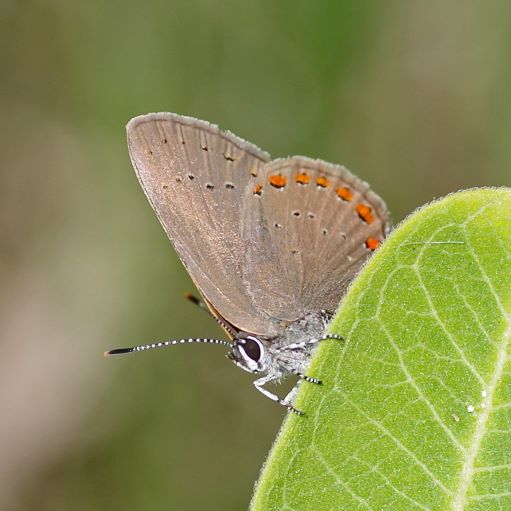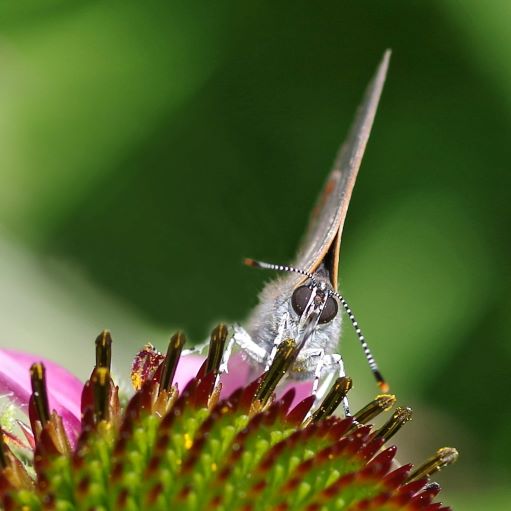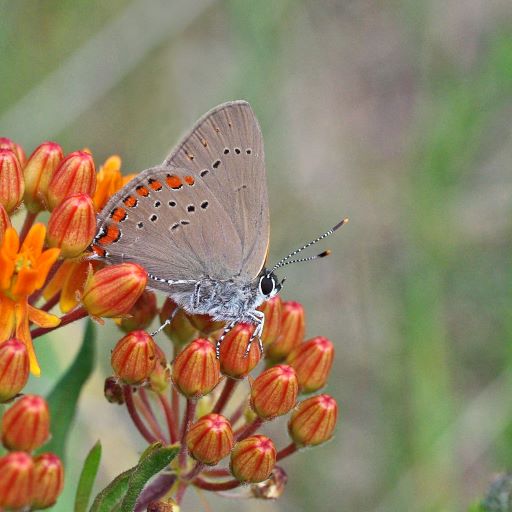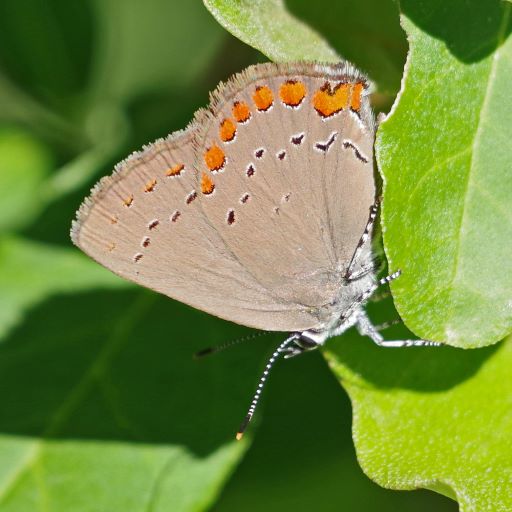
Coral Hairstreak Butterfly
Howdy, BugFans,
Hairstreaks (and Blues and Coppers and Harvesters) are members of the Gossamer-winged butterfly family Lycaenidae (“Gossamer-winged” being a nod to the iridescent sheen on the wings of many family members). Numbering nearly 5,000 mostly tropical species worldwide – 30% of butterfly species – Lycaenidae is the second-largest butterfly family (the Brush-foots outnumber them). The BugLady associates hairstreak butterflies with butterfly weed and hot, sunny prairie days.
Family members share characteristics like indented eyes, striped antennae, a narrow face, reduced forelegs (males more than females), bright colors, and (frequently) hair-like “tails” on the edge of the hind wing. The tails are often located near a blue-pigmented “eyespot” on the wing – hairstreaks often land head-down, and the eyes and antenna-like tails are said to present a predator with a “false head.” The tails are fragile and can be worn off or may be bitten off by a misdirected predator (better to lose a chunk of a wing than your actual head).
With the exception of the carnivorous Harvester larvae, the slug-like Lycaenid caterpillars are herbivores; adult Lycaenids feed at flowers and also get nutrients from damp mud, decaying fruit, and carrion. Caterpillars of many species of Gossamer-wings are myrmecophiles – they have friendly relationships with ants, trading food for protection. Caterpillars of some species are able to communicate with or summon their ants by producing vibrations that travel through the substrate.



CORAL HAIRSTREAKS (Satyrium titus) aren’t gaudy, but they’re still pretty spiffy little butterflies. They are hairstreaks without hairstreaks, and they don’t have blue eyespots on the edge of their wings, either https://bugguide.net/node/view/23133 (compare it to the similar Acadian Hairstreak, which has both https://bugguide.net/node/view/1490067/bgpage). Coral Hairstreaks close their wings immediately upon landing, so the BugLady couldn’t find any picture of the dorsal side of their wings other than this pinned specimen https://digitalatlas.cose.isu.edu/bio/insects/butrfly/famlyc/satif.htm. They have a wingspread of 1” to 1 ½”, and males and females look alike except that the male’s wings are somewhat more triangular in shape. Here are more pictures https://www.marylandbiodiversity.com/view/513.
Coral Hairstreaks are found across much of North America https://bugguide.net/node/view/4115/data. They need two habitats, with adults visiting (and pollinating) flowers, especially butterfly weed, in open areas like grasslands, roadsides, clearings, pastures, and gardens; and caterpillars feeding on the new leaves, flowers, and even the new fruit of Black cherry and a few of its close relatives in young woods and around woodland edges. Some hairstreak species are woodland-dwellers, but maturing woodlands become less attractive to Coral Hairstreaks, and land use practices affect their numbers.
Aggressive males perch on vegetation and chase females and other insect intruders, and they court using pheromones (smells) and visual displays. Females lay eggs on twigs, at the base of a host tree or in nearby leaf litter, leaving a scent mark to indicate to other females that the spot has been taken. The eggs overwinter, hatching in spring as the new vegetation erupts https://bugguide.net/node/view/1683166/bgimage. There’s one generation per year.
Although Coral Hairstreaks fly fast and erratically, most don’t disperse very far away from where they hatched. On cool mornings, they warm up by sitting with wings closed, at right angles to the sun (lateral basking).
According to the great University of Michigan Biokids website http://www.biokids.umich.edu/critters/Lycaenidae/, lacewings and ladybug beetles eat hairstreak eggs; ants, wasps, and the larvae of parasitic flies eat the caterpillars; mice and shrews feed on the pupae; and mantises, spiders, birds, frogs, and toads stalk the adults. If they can connect with the proper species of ant, the caterpillars will be protected by them in return for allowing the ants to harvest drops of honeydew that caterpillars produce in a “honey gland” (dorsal nectary organ) http://www.pbase.com/spjaffe/image/125237720). Caterpillars feed at night, attended by ants, and rest in the leaf litter below the cherry tree by day.
Data from the marvelous Butterflies of Massachusetts website (https://www.butterfliesofmassachusetts.net/index.htm), where they have crunched the numbers for 150 years’ worth of butterfly sightings, suggest that warming temperatures due to climate change are causing Coral Hairstreaks there to begin their flight period two weeks ahead of the historical dates – at the beginning of July rather than the middle of July (and this is undoubtedly happening elsewhere).
Kate Redmond, The BugLady
Bug of the Week archives:
http://uwm.edu/field-station/category/bug-of-the-week/
